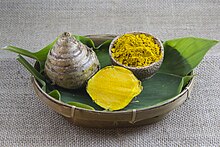| Curcuma zanthorrhiza | |
|---|---|

| |
| Scientific classification | |
| Kingdom: | Plantae |
| Clade: | Tracheophytes |
| Clade: | Angiosperms |
| Clade: | Monocots |
| Clade: | Commelinids |
| Order: | Zingiberales |
| Family: | Zingiberaceae |
| Genus: | Curcuma |
| Species: | C. zanthorrhiza
|
| Binomial name | |
| Curcuma zanthorrhiza | |
| Synonyms | |
|
Curcuma xanthorrhiza Roxb. orth. var.[1] | |
Curcuma zanthorrhiza, known as temulawak, Java ginger, Javanese ginger, or Javanese turmeric is a plant species, belonging to the ginger family.[2] It is known in Javanese as temulawak, in Sundanese as koneng gede and in Madurese as temu labak.[2] The scientific name is sometimes written as Curcuma xanthorrhiza, but this is an orthographical variant.
This plant originated from Indonesia, more specifically from Java island, out of which it spread to several places in the biogeographical region Malesia. Currently, most of the temu lawak is cultivated in Indonesia, Malaysia, Thailand, and the Philippines.[3] Outside of South East Asia, cultivars may be found also in China, Indochina, Barbados, India, Japan, Korea, the United States and some countries in Europe.
Curcuma zanthorrhiza flourishes up to 1500 m above sea level in a tropical climate.[3] Its rhizomes develop well in loose soil.[4]
Uses[edit]

Curcuma zanthorrhiza is used as a medicinal plant. The rhizome contains an ethereal oil (5ml per kg), it primarily consists of Sesquiterpenes. There is also a content of Curcumin (at least 1%, Ph. Eur.) and starch. Curcuma zanthorrhiza is used for dyspepsia. It is a spice too.[5] According to one source it is an effective deterrent and pesticide of mushroom mites.[6] In Java, there is a drink made from the juice of Curcuma zanthorrhiza called sari temulawak.[7]
References[edit]
- ^ Leong-Škorničková, Jana; Šída, Otakar; Marhold, Karol (2010). "Back to types! Towards stability of names in Indian Curcuma L. (Zingiberaceae)" (PDF). Taxon. 59 (1). International Association for Plant Taxonomy: 269–282. doi:10.1002/tax.591025. Retrieved 20 December 2012.
- ^ a b Mahendra, B: “13 Jenis Tanaman Obat Ampuh”, page 95. Penebar Swadaya, 2005
- ^ a b Rukmana, R: “Temu-Temuan”, page 14. Kanisius, 2004
- ^ Hidayat, S. dan Tim Flona: “Khasiat Tumbuhan Berdasar Warna, Bentuk, Rasa, Aroma, dan Sifat”, page 105. PT Samindra Utama, 2008
- ^ Bettina Rahfeld: Mikroskopischer Farbatlas pflanzlicher Drogen, Spektrum Akademischer Verlag, 2009. ISBN 978-3-8274-1951-4.
- ^ Bussaman, Prapassorn; Sa-uth, Chirayu; Rattanasena, Paweena; Chandrapatya, Angsumarn (2012). "Effect of Crude Plant Extracts on Mushroom Mite, sp. (Acari: Pygmephoridae)". Psyche: A Journal of Entomology. 2012: 1–5. doi:10.1155/2012/150958.
- ^ Kinamu, Bare Kingkin; Permadi, Galih. "Cari Minuman Sari Temulawak di Semarang? Coba Datang ke Angkringan Ini". tribunnews.com (in Indonesian). Tribun Jateng. Retrieved 7 May 2023.